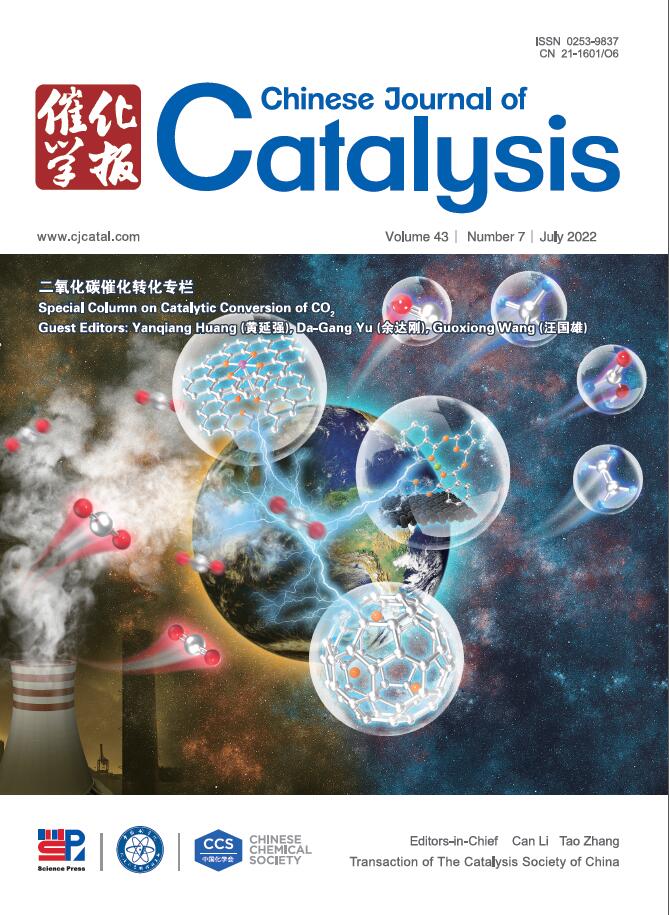Advances in iron-based Fischer-Tropsch synthesis with high carbon efficiency
IF 17.7
1区 化学
Q1 CHEMISTRY, APPLIED
引用次数: 0
Abstract
Fischer-Tropsch synthesis offers a promising route to convert carbon-rich resources such as coal, natural gas, and biomass into clean fuels and high-value chemicals via syngas. Catalyst development is crucial for optimizing the process, with cobalt- and iron-based catalysts being widely used in industrial applications. Iron-based catalysts, in particular, are favored due to their low cost, broad temperature range, and high water-gas shift reaction activity, making them ideal for syngas derived from coal and biomass with a low H2/CO ratio. However, despite their long history of industrial use, iron-based catalysts face two significant challenges. First, the presence of multiple iron phases-metallic iron, iron oxides, and iron carbides-complicates the understanding of the reaction mechanism due to dynamic phase transformations. Second, the high water-gas shift activity of these catalysts leads to increased CO2 selectivity, thereby reducing overall carbon efficiency. In Fischer-Tropsch synthesis, CO2 can arise as primary CO2 from CO disproportionation (the Boudouard reaction) and as secondary CO2 from the water-gas shift reaction. The accumulation of CO2 formation further compromises overall carbon efficiency, which is particularly undesirable given the current focus on minimizing carbon emissions and achieving carbon neutrality. This review focus on the ongoing advancements of iron-based catalysts for Fischer-Tropsch synthesis, with particular emphasis on overcoming these two critical challenges for iron-based catalysts: regulating the active phases and minimizing CO2 selectivity. Addressing these challenges is essential for enhancing the overall catalytic efficiency and selectivity of iron-based catalysts. In this review, recent efforts to suppress CO2 selectivity of iron-based catalysts, including catalyst hydrophobic modification and graphene confinement, are explored for their potential to stabilize active phases and prevent unwanted side reactions. This innovative approach offers new opportunities for developing catalysts with high activity, low CO2 selectivity, and enhanced stability, which are key factors for enhancing both the efficiency and sustainability for Fischer-Tropsch synthesis. Such advancements are crucial for advancing more efficient and sustainable Fischer-Tropsch synthesis technologies, supporting the global push for net-zero emissions goals, and contributing to carbon reduction efforts worldwide.
高碳效率铁基费托合成研究进展
费托合成提供了一条很有前途的途径,通过合成气将煤、天然气和生物质等富含碳的资源转化为清洁燃料和高价值化学品。催化剂的开发对优化工艺至关重要,钴基和铁基催化剂在工业应用中得到广泛应用。特别是铁基催化剂,由于其低成本、宽温度范围和高水气转换反应活性而受到青睐,使其成为低H2/CO比的煤和生物质合成气的理想选择。然而,尽管铁基催化剂的工业应用历史悠久,但它们面临着两个重大挑战。首先,多种铁相的存在——金属铁、氧化铁和碳化物铁——由于动态相变而使对反应机理的理解复杂化。其次,这些催化剂的高水气转换活性导致二氧化碳选择性增加,从而降低了整体碳效率。在费托合成中,CO歧化反应(Boudouard反应)产生的CO2为初级CO2,水气变换反应产生的CO2为次级CO2。二氧化碳的积累进一步降低了整体的碳效率,考虑到目前的重点是尽量减少碳排放和实现碳中和,这是特别不可取的。本文综述了用于费托合成的铁基催化剂的最新进展,重点介绍了铁基催化剂克服的两个关键挑战:调节活性相和降低CO2选择性。解决这些问题对于提高铁基催化剂的整体催化效率和选择性至关重要。本文综述了近年来抑制铁基催化剂的CO2选择性的研究成果,包括催化剂疏水改性和石墨烯约束,探讨了它们稳定活性相和防止不良副反应的潜力。这种创新的方法为开发高活性、低CO2选择性和增强稳定性的催化剂提供了新的机会,这是提高费托合成效率和可持续性的关键因素。这些进步对于推进更高效和可持续的费托合成技术,支持全球推动净零排放目标,并为全球碳减排努力做出贡献至关重要。
本文章由计算机程序翻译,如有差异,请以英文原文为准。
求助全文
约1分钟内获得全文
求助全文
来源期刊

Chinese Journal of Catalysis
工程技术-工程:化工
CiteScore
25.80
自引率
10.30%
发文量
235
审稿时长
1.2 months
期刊介绍:
The journal covers a broad scope, encompassing new trends in catalysis for applications in energy production, environmental protection, and the preparation of materials, petroleum chemicals, and fine chemicals. It explores the scientific foundation for preparing and activating catalysts of commercial interest, emphasizing representative models.The focus includes spectroscopic methods for structural characterization, especially in situ techniques, as well as new theoretical methods with practical impact in catalysis and catalytic reactions.The journal delves into the relationship between homogeneous and heterogeneous catalysis and includes theoretical studies on the structure and reactivity of catalysts.Additionally, contributions on photocatalysis, biocatalysis, surface science, and catalysis-related chemical kinetics are welcomed.
 求助内容:
求助内容: 应助结果提醒方式:
应助结果提醒方式:


